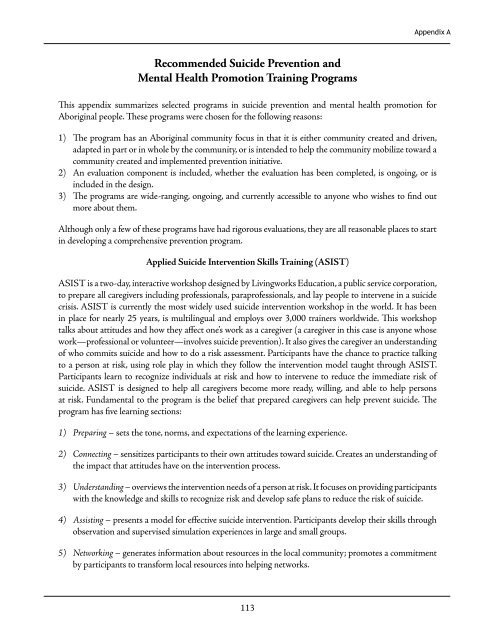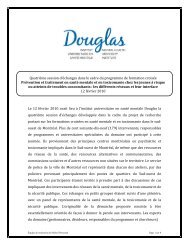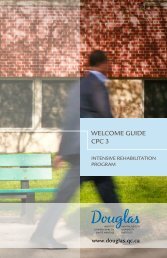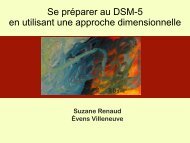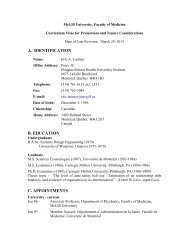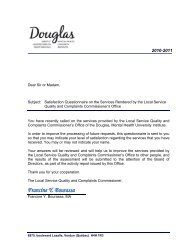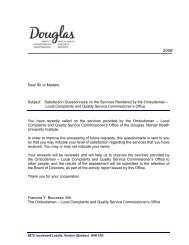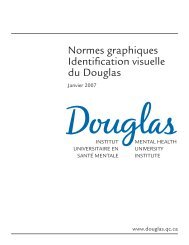Appendix ARecommended <strong>Suicide</strong> Prevention andMental Health Promotion Tra<strong>in</strong><strong>in</strong>g ProgramsThis appendix summarizes selected programs <strong>in</strong> suicide prevention and mental health promotion for<strong>Aborig<strong>in</strong>al</strong> people. These programs were chosen for the follow<strong>in</strong>g reasons:1) The program has an <strong>Aborig<strong>in</strong>al</strong> community focus <strong>in</strong> that it is either community created and driven,adapted <strong>in</strong> part or <strong>in</strong> whole by the community, or is <strong>in</strong>tended to help the community mobilize toward acommunity created and implemented prevention <strong>in</strong>itiative.2) An evaluation component is <strong>in</strong>cluded, whether the evaluation has been completed, is ongo<strong>in</strong>g, or is<strong>in</strong>cluded <strong>in</strong> the design.3) The programs are wide-rang<strong>in</strong>g, ongo<strong>in</strong>g, and currently accessible to anyone who wishes to f<strong>in</strong>d outmore about them.Although only a few of these programs have had rigorous evaluations, they are all reasonable places to start<strong>in</strong> develop<strong>in</strong>g a comprehensive prevention program.Applied <strong>Suicide</strong> Intervention Skills Tra<strong>in</strong><strong>in</strong>g (ASIST)ASIST is a two-day, <strong>in</strong>teractive workshop designed by Liv<strong>in</strong>gworks Education, a public service corporation,to prepare all caregivers <strong>in</strong>clud<strong>in</strong>g professionals, paraprofessionals, and lay people to <strong>in</strong>tervene <strong>in</strong> a suicidecrisis. ASIST is currently the most widely used suicide <strong>in</strong>tervention workshop <strong>in</strong> the world. It has been<strong>in</strong> place for nearly 25 years, is multil<strong>in</strong>gual and employs over 3,000 tra<strong>in</strong>ers worldwide. This workshoptalks about attitudes and how they affect one’s work as a caregiver (a caregiver <strong>in</strong> this case is anyone whosework—professional or volunteer—<strong>in</strong>volves suicide prevention). It also gives the caregiver an understand<strong>in</strong>gof who commits suicide and how to do a risk assessment. Participants have the chance to practice talk<strong>in</strong>gto a person at risk, us<strong>in</strong>g role play <strong>in</strong> which they follow the <strong>in</strong>tervention model taught through ASIST.Participants learn to recognize <strong>in</strong>dividuals at risk and how to <strong>in</strong>tervene to reduce the immediate risk ofsuicide. ASIST is designed to help all caregivers become more ready, will<strong>in</strong>g, and able to help personsat risk. Fundamental to the program is the belief that prepared caregivers can help prevent suicide. Theprogram has five learn<strong>in</strong>g sections:1) Prepar<strong>in</strong>g – sets the tone, norms, and expectations of the learn<strong>in</strong>g experience.2) Connect<strong>in</strong>g – sensitizes participants to their own attitudes toward suicide. Creates an understand<strong>in</strong>g ofthe impact that attitudes have on the <strong>in</strong>tervention process.3) Understand<strong>in</strong>g – overviews the <strong>in</strong>tervention needs of a person at risk. It focuses on provid<strong>in</strong>g participantswith the knowledge and skills to recognize risk and develop safe plans to reduce the risk of suicide.4) Assist<strong>in</strong>g – presents a model for effective suicide <strong>in</strong>tervention. Participants develop their skills throughobservation and supervised simulation experiences <strong>in</strong> large and small groups.5) Network<strong>in</strong>g – generates <strong>in</strong>formation about resources <strong>in</strong> the local community; promotes a commitmentby participants to transform local resources <strong>in</strong>to help<strong>in</strong>g networks.113
Appendix AASIST participants receive the ASIST Handbook, a Help Card and a workbook. Although the program wasorig<strong>in</strong>ally designed for caregivers <strong>in</strong> the general population, ASIST is widely used <strong>in</strong> <strong>Aborig<strong>in</strong>al</strong> communities.While the <strong>in</strong>formation presented is basically the same as workshops presented <strong>in</strong> other communities, thetra<strong>in</strong>ers work<strong>in</strong>g with <strong>Aborig<strong>in</strong>al</strong> groups are experienced <strong>in</strong> adapt<strong>in</strong>g the material so that it is relevant tothe community. <strong>Aborig<strong>in</strong>al</strong> and non-<strong>Aborig<strong>in</strong>al</strong> tra<strong>in</strong>ers are often brought together to present this 2-dayASIST workshop for <strong>Aborig<strong>in</strong>al</strong> communities. The ASIST workshop has been evaluated many times.Evaluations are available from Liv<strong>in</strong>gworks Education (the authors of the program). Results <strong>in</strong>dicate an<strong>in</strong>crease <strong>in</strong> caregiver competence and confidence follow<strong>in</strong>g the workshop.An example of the program <strong>in</strong> use is the Calgary Urban <strong>Aborig<strong>in</strong>al</strong> <strong>Suicide</strong> Prevention Committee II‐PAA-TAA-PII (IPTP), a coalition of social service agencies and <strong>Aborig<strong>in</strong>al</strong> community members. The committeeprovides education and awareness of suicide prevention issues to urban <strong>Aborig<strong>in</strong>al</strong> community members.S<strong>in</strong>ce its <strong>in</strong>ception <strong>in</strong> 2003, IPTP has tra<strong>in</strong>ed five <strong>Aborig<strong>in</strong>al</strong> tra<strong>in</strong>ers to present the ASIST workshop.IPTP provides highly subsidized ASIST workshops to the local <strong>Aborig<strong>in</strong>al</strong> community. IPTP has alsodeveloped a local suicide help card, provided 2-hour awareness presentations to a variety of local groups andcommunities, and is currently develop<strong>in</strong>g a one-half day workshop on suicide and <strong>Aborig<strong>in</strong>al</strong> people.5-Day <strong>Suicide</strong> Prevention Tra<strong>in</strong><strong>in</strong>g for <strong>Aborig<strong>in</strong>al</strong> CommunitiesThe 5-Day <strong>Suicide</strong> Prevention Tra<strong>in</strong><strong>in</strong>g for <strong>Aborig<strong>in</strong>al</strong> Communities was commissioned by the RoyalCanadian Mounted Police (RCMP) National <strong>Aborig<strong>in</strong>al</strong> Polic<strong>in</strong>g Services and was created by <strong>Suicide</strong>Prevention Tra<strong>in</strong><strong>in</strong>g Programs (SPTP), a branch of the Centre for <strong>Suicide</strong> Prevention. The Centre for<strong>Suicide</strong> Prevention is a non-profit organization dedicated to provid<strong>in</strong>g <strong>in</strong>formation, research, and tra<strong>in</strong><strong>in</strong>gregard<strong>in</strong>g suicide prevention.<strong>Suicide</strong> Prevention Tra<strong>in</strong><strong>in</strong>g Programs (SPTP) developed a flexible, five-day workshop to address the issueof suicide <strong>in</strong> <strong>Aborig<strong>in</strong>al</strong> communities. The five-day workshop has been presented throughout <strong>Canada</strong>, <strong>in</strong>every prov<strong>in</strong>ce and territory. Many of the workshops have been conducted as part of a suicide preventionstrategy of the RCMP National <strong>Aborig<strong>in</strong>al</strong> Polic<strong>in</strong>g Services Branch. SPTP was selected to develop theprogram for the RCMP, mak<strong>in</strong>g it the first national <strong>in</strong>itiative to address suicide prevention <strong>in</strong> <strong>Aborig<strong>in</strong>al</strong>communities. While there is a generic workshop format, each program is tailor-made to fit the needs of theparticular community. The workshop is <strong>in</strong>teractive and engag<strong>in</strong>g, <strong>in</strong>volv<strong>in</strong>g small and large group discussions,videos, practice role-plays, talk<strong>in</strong>g circles, and group strategy sessions. When appropriate, local Elders are<strong>in</strong>vited to speak about local traditions and to conduct ceremonies. Workshop organizers, participants,and community members are encouraged to <strong>in</strong>corporate their community traditions and ceremonies <strong>in</strong>tothe five days of the workshop. Elders provide open<strong>in</strong>g and clos<strong>in</strong>g ceremonies for the workshops whenapplicable. In some communities, there are requests for a local Elder to come and talk about local traditions,culture, and the <strong>Aborig<strong>in</strong>al</strong> view of life, death, suicide, and griev<strong>in</strong>g. The full-day talk<strong>in</strong>g circle is generallyco-facilitated by an SPTP tra<strong>in</strong>er and a local Elder. This workshop is designed to provide suicide andcrisis <strong>in</strong>tervention tra<strong>in</strong><strong>in</strong>g for community members, have members learn about bereavement, as well as givemembers an opportunity to share their own feel<strong>in</strong>gs of loss and thoughts about suicide and other issues <strong>in</strong>their community. While the program is flexible and is retooled before each workshop, the follow<strong>in</strong>g corecomponents are most often used:114
- Page 1 and 2:
Suicide Among Aboriginal Peoplein C
- Page 3 and 4:
Aboriginal Healing Foundation75 Alb
- Page 6 and 7:
Table of ContentsPreface...........
- Page 8 and 9:
Table of ContentsCultural and Lingu
- Page 10:
PrefaceThis report was prepared und
- Page 14 and 15:
GlossaryAmbivalence - Ambivalence r
- Page 16 and 17:
GlossaryParasuicide - Any acute, in
- Page 18 and 19:
Chapter 1IntroductionWhen I was 14
- Page 20 and 21:
Chapter 1Definitions of Suicide and
- Page 22 and 23:
Chapter 1Methods of Studying Suicid
- Page 24 and 25:
Chapter 1suicide attempts (Marttune
- Page 26 and 27:
Chapter 1A central problem for cros
- Page 28 and 29:
Chapter 2The Epidemiology of Suicid
- Page 30 and 31:
Chapter 2the economic status of Abo
- Page 32 and 33:
Chapter 2No study to date has syste
- Page 34 and 35:
Chapter 2Despite the overall patter
- Page 36 and 37:
Chapter 2Figure 2-6) Average Annual
- Page 38 and 39:
Chapter 2are only a portion of thos
- Page 40 and 41:
Chapter 2Figure 2-9) Suicide Rates
- Page 42 and 43:
Chapter 2Indeed, the rising rate of
- Page 44 and 45:
Chapter 2Figure 2-11) Number of Dea
- Page 46 and 47:
Chapter 2Rate per 100,000 populatio
- Page 48 and 49:
Chapter 2There are only a handful o
- Page 50 and 51:
Chapter 3Origins of Suicide: Indivi
- Page 52 and 53:
Chapter 3Anxiety disorders also car
- Page 54 and 55:
Chapter 3Many of the factors associ
- Page 56 and 57:
Chapter 3American Indians compared
- Page 58 and 59:
Chapter 3genetic and constitutional
- Page 60 and 61:
Chapter 3Single-parent families are
- Page 62 and 63:
Chapter 3Hopelessness, Problem Solv
- Page 64 and 65:
Chapter 3higher rates of suicidal b
- Page 66 and 67:
Chapter 3Physical EnvironmentSuicid
- Page 68 and 69:
Chapter 31990; Chandler, 1994). Thi
- Page 70 and 71:
Chapter 3Risk FactorsDepressionSubs
- Page 72 and 73:
Chapter 4Origins of Suicide: Social
- Page 74 and 75:
Chapter 4Reserves, Settlements, and
- Page 76 and 77:
Chapter 4Traditionalism versus accu
- Page 78 and 79: Chapter 4are equivalent in seriousn
- Page 80 and 81: Chapter 4society (Levy and Kunitz,
- Page 82 and 83: Chapter 4those of mother and homema
- Page 84 and 85: Chapter 4Duncan Campbell Scott, Dep
- Page 86 and 87: Chapter 4Traditional Aboriginal com
- Page 88 and 89: Chapter 4Feehan, 1996; Grant, 1996;
- Page 90 and 91: Chapter 4The Child Welfare System a
- Page 92 and 93: Chapter 4Aboriginal communities and
- Page 94 and 95: Chapter 4had extremely high rates.
- Page 96 and 97: Chapter 4Figure 4-2) Transgeneratio
- Page 98 and 99: Chapter 5What Works in Suicide Prev
- Page 100 and 101: Chapter 5Table 5-1) Strategies of I
- Page 102 and 103: Chapter 5Effective Suicide Preventi
- Page 104 and 105: Chapter 5closet rods that give way
- Page 106 and 107: Chapter 5The American Indian Life S
- Page 108 and 109: Chapter 51) school-based and commun
- Page 110 and 111: Chapter 5reduce suicides that follo
- Page 112 and 113: Chapter 5Although they may visit a
- Page 114 and 115: Chapter 6Conclusion: Understanding
- Page 116 and 117: Chapter 6Figure 6-1) An Integrative
- Page 118 and 119: Chapter 6in large urban settings th
- Page 120 and 121: Chapter 6there’s like a program s
- Page 122 and 123: Chapter 6Figure 6-2) Levels of Inte
- Page 124 and 125: Chapter 6Planning and CoordinationA
- Page 126 and 127: Chapter 62) The response to the cri
- Page 128: Chapter 6Often, suicide is a respon
- Page 133 and 134: Appendix AThe Training for Youth Ed
- Page 135 and 136: Appendix AThe program has continued
- Page 137 and 138: Appendix Awith the creation and imp
- Page 139 and 140: Appendix AContact Information for R
- Page 142 and 143: Appendix BAdditional Resources: Man
- Page 144: Appendix BAboriginal Healing and We
- Page 147 and 148: Appendix CNational Aboriginal Healt
- Page 149 and 150: References——— (1987). Unravel
- Page 151 and 152: ReferencesBeck, A.T., R.A. Steer, M
- Page 153 and 154: ReferencesBrent, D.A., J.A. Perper,
- Page 155 and 156: References——— (1995). The Pro
- Page 157 and 158: ReferencesDevereux, G. (1961). Moha
- Page 159 and 160: References——— (2005b). In wha
- Page 161 and 162: ReferencesGardiner, H. and B. Gaida
- Page 163 and 164: ReferencesGuo, B. and C. Harstall (
- Page 165 and 166: ReferencesHoberman, H.M. and B.D. G
- Page 167 and 168: ReferencesJong, M. (2004). Managing
- Page 169 and 170: ReferencesKouri, R. (2003). Persona
- Page 171 and 172: References——— (1997). Suicide
- Page 173 and 174: ReferencesMatheson, L. (1996). The
- Page 175 and 176: ReferencesNeimeyer, R.A., B. Fortne
- Page 177 and 178: ReferencesPirkis, J.E., C.E. Irwin,
- Page 179 and 180:
ReferencesRutz, W. (2001). Preventi
- Page 181 and 182:
References——— (1992). Marriag
- Page 183 and 184:
ReferencesTrimble, J. and B. Medici
- Page 185 and 186:
ReferencesWebb, J.P. and W. Willard


